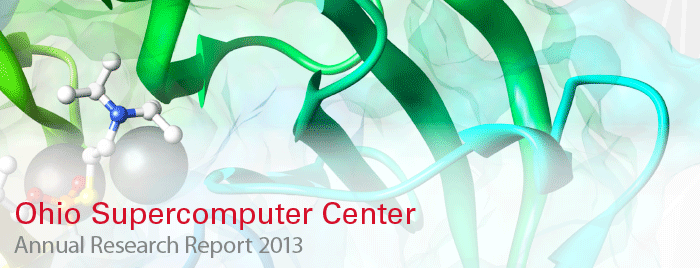Professor Giorgio Rizzoni, graduate student Casie Clark and the Venturi Buckeye Bullet 3. The VBB3 team recently tested the new streamliner at Wendover, Utah. Clark, the team aerodynamicist, used Ohio Supercomputer Center resources to make numerous studies of the vehicle, including a pressure contour (top) and a velocity contour (bottom) at 300 miles-per-hour. (Photo credit: Denis Broussard, Venturi Automobiles)
The Venturi Buckeye Bullet 3 (VBB3) is a streamlined electric land-speed race car designed and assembled by undergraduate and graduate students at The Ohio State University’s Center for Automotive Research (OSU CAR). After setting world and international speed records with previous vehicles, the team recently built a new streamliner with the latest electric drive technology from program partner Venturi Automotive, an electric car company based in Monaco. The new drive train is capable of more than 2,000 horsepower and is expected to eventually thrust
the four-wheel drive VBB3 to speeds in excess of 400 mph, making it the first electric vehicle to surpass this mark. Its predecessors were the first (and are to date the only) electric vehicles to exceed 300 mph.
“At these high speeds, aerodynamics play a crucial role in vehicle and driver safety, as well as being one of the critical factors that dictate the peak performance of the vehicle,” said Giorgio Rizzoni, Ph.D., Ohio State professor of mechanical and aerospace engineering and director of OSU CAR. “From the start of the design process, the aerodynamics of each proposed body shape for the VBB3 was evaluated in Fluent and OpenFOAM using the computational resources available at the Ohio Supercomputer Center.”
In addition to optimizing the body shape to achieve minimum drag, packaging constraints and vehicle stability considerations played a major role in the final design. For example, to ensure the desired yaw stability at high speed, extensive simulations were run to evaluate the effectiveness of the vertical tail, which underwent several design iterations. Then, several new runs and studies were launched to evaluate the overall aerodynamic performance of the vehicle, with some solutions involving more than 42 million cells.
“Since it’s a new car with a new body, it has been interesting to look at the current aero, and to identify areas of improvement,” said Casie Clark, an Ohio State graduate student in aeronautical and astronautical engineering. “For example, I ran CFD jobs aimed at designing a wind deflector to deflect air around the tires, instead of allowing a large air mass inside the wheel wells, which creates substantial drag.”
The team recently transported the VBB3 to Wendover, Utah, where, despite flooding that forced cancellation of the international time trials, the team tested and refined the streamliner at the local airport’s 1.5-mile long runway.
Project Lead: Giorgio Rizzoni, The Ohio State University
Research Title: CFD simulations of the Buckeye Bullet electric car
Funding Source: The Ohio State University, Venturi Automobiles

